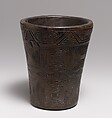Kero
Not on view
Tumbler-shaped drinking vessels—called keros when made of wood and aquillas when made of gold and silver—were used in Peru to consume chicha (corn beer) for hundreds of years before the Inca came to power. During Inca times, they were made and used in pairs since custom required that two individuals drink together. Both vessels had the same size, shape, and decoration. To consolidate the relationship between local communities and the Inca state, toasts were exchanged during ceremonial occasions and pairs of keros, often together with fine textiles, were given to provincial leaders as a sign of Inca generosity.
As with other Inca works, kero production was state controlled and highly standardized, showing uniformity in size and decoration. The finely incised lines meet at angles to form a series of geometric shapes that can be read as squares, triangles, or diamonds. They are typically arranged in two to four horizontal registers, as seen on this cup. The upper register shows frontal faces rendered in a linear, geometric style characteristic of Inca aesthetics.
Due to rights restrictions, this image cannot be enlarged, viewed at full screen, or downloaded.

